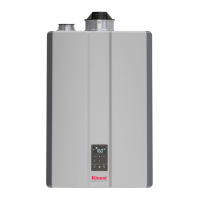14 Rinnai I-Series Condensing Boiler Combi Manual
• Installaon Guidelines
• What You’ll Need
• Items Included
• Choose an Installaon Locaon
• Mount the Boiler to the Wall
• Fill the Condensate Collector
THIS SECTION IS INTENDED
FOR THE INSTALLER
Installer qualicaons: A trained and qualied
professional must install the appliance,
inspect it, and leak test the boiler before use.
The warranty will be voided due to any
improper installaon. The trained and
qualied professional should have skills such
as: Gas sizing; Connecng gas lines, water
lines, valves, and electricity; Knowledge of
applicable naonal, state, and local codes;
Installing venng through a wall or roof; and
training in installaon of condensing boilers.
Training for Rinnai Condensing Boilers is
accessible online at
www.trainingevents.rinnai.us.
Topics in this secon
4
• This boiler is cered for installaon in
residenal and commercial applicaons.
• This boiler is suitable for combinaon
water heang and central heang.
• The installaon must conform with local
codes or, in the absence of local codes,
with the Naonal Fuel Gas Code, ANSI
Z223.1/NFPA 54, or the Natural Gas and
Propane Installaon Code, CSA B149.1. If
installed in a manufactured home, the
installaon must conform with the
Manufactured Home Construcon and
Safety Standard, Title 24 CFR, Part 3280
and/or CAN/SCA Z240 MH Series, Mobile
Homes.
• The appliance, when installed, must be
electrically grounded in accordance with
local codes or, in the absence of local
codes, with the Naonal Electrical Code,
ANSI/NFPA 70, or the Canadian
Electrical Code, CSA C22.1.
• The appliance and its main gas valve
must be disconnected from the gas
supply piping system during any
pressure tesng of that system at test
pressures in excess of 1/2 psi (3.5 kPa)
(13.84 in W.C.). For system tesng at
pressures less than or equal to 1/2 psi
(3.5 kPa) (13.84 in W.C.) the appliance
must be isolated from the gas supply
piping by closing its individual manual
shuto valve.
• You must follow the installaon
instrucons and those in secon
“5. Venng” for adequate combuson
air and exhaust.
• If this boiler’s DHW system is connected
to a closed water supply system, such as
one having a backow preventer in the
cold water supply line, means shall be
provided to control thermal expansion.
Contact the water supplier or local
plumbing inspector on how to control
thermal expansion.
• Should overheang occur or the gas
supply fail to shut o, turn o the
manual gas control valve to the
appliance.
• Combuson air must be free of
chemicals, such as chlorine or bleach,
that produce fumes. These fumes can
damage components and reduce the life
of your appliance.
• Where required by the authority having
jurisdicon, the installaon must comply
with the Standard for Controls and
Safety Devices for Automacally Fired
Boilers, ANSI/ASME CSD-1.

